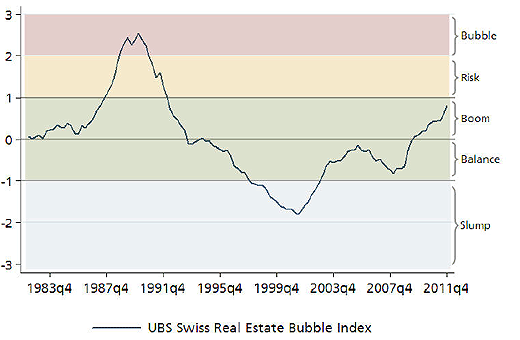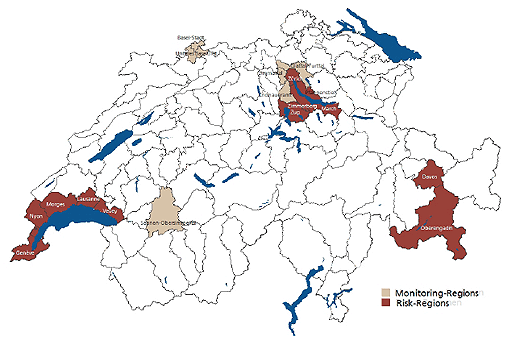The quarterly UBS Swiss Real Estate Bubble Index has reached 0.80, an increase of 0.22 index points since the last quarter. A score of 0.80 indicates a continued housing market boom in Switzerland. As the index reaches its highest level for almost 20 years, it is edging closer to the risk zone (greater than 1).
The steep rise has been fueled by a relatively strong surge in home prices, slight deflation and stagnant incomes. The impact of record-low interest rates is also hard to ignore. The fourth quarter saw aboveaverage increases in household mortgage debt and the proportion of credit application for residential property not intended for owner occupancy. This reflects burgeoning investor interest in real estate given the lack of investment alternatives.
The real estate market trend will probably become even more pronounced this year. UBS Wealth Management Research Switzerland expects a fall in consumer prices of 0.3 percent and weak economic growth of 0.4 percent for the entire year. In other words, the economic climate doesn't justify further price hikes. However, low interest rates should keep demand strong until the end of 2012 and prices should keep booming for the foreseeable future.
UBS Wealth Management Research Switzerland publishes a regional risk map at the same time as the UBS Swiss Real Estate Bubble Index. The map showed no quarter-on-quarter change in the number of regions with a substantial risk of a regional home price correction. While the number of risk regions is relatively low, they nonetheless hold around 22 percent of the total Swiss population. One change has occurred, however: Basel-Stadt, Glatttal-Furttal and Knonaueramt are now "monitoring regions". These are regions that show a higher risk, but are not yet risk regions.

Method
Depending on its current value, the index falls into one of the following risk categories: slump, balance, boom, risk and bubble. These categories are specifically defined and ranked in order of risk. The UBS Swiss Real Estate Bubble Index is comprised of six sub-indices that track: the relationship between purchase and rental prices, the relationship between house prices and household income, the development of house prices relative to inflation, the relationship between mortgage debt and income, the relationship between construction and gross domestic product (GDP), and the ratio of loan applications filed for intended rental properties to total loan applications filed by UBS private clients.
Selecting risk and monitoring regions
Our selection of risk regions is tied to the level of the UBS Swiss Real Estate Bubble Index and is based on a multi-level selection process utilizing regional population and property price data.
The group of risk regions remains unchanged. The Zurich, Geneva and Lausanne MS regions remain Switzerland's most risky as a result of their national importance. Other regions considered risky include the large metropolitan areas of Zug, Pfannenstiel, Zimmerberg, March, Vevey, Morges and Nyon, as well as the tourist regions of Davos and Oberengadin. The group of monitoring regions, by contrast, has grown to include Basel-Stadt, Glattal-Furttal and Knonaueramt. This category still includes Limmattal, Unteres Baselbiet and Saanen-Obersimmental.
Regional risk map: 4th Quarter 2011

Contacts
Claudio Saputelli
Head of WM Real Estate & Swiss Regional Research
Tel. +41 79 513 50 45
Dr. Matthias Holzhey
Economist WM Real Estate & Swiss Regional Research
Tel. +41 44 234 71 25
The next date of publication for the UBS Swiss Real Estate Bubble Index is 3 May, 2012.

